High ocean temperatures are harming the Florida coral reef. Rescue crews are racing to help
LAYTON, Fla. (AP) — Steps away from the warming waters of Florida Bay, marine biologist Emily Becker removed covers from the dozens of water-filled tanks under her watchful eye. Nestled in seawater carefully maintained at about 85 degrees Fahrenheit (29 degrees Celsius) lay hundreds of pieces of coral — some a sickly white from the bleaching that threatens to kill them, others recovered to a healthy bright iodine in color.
As Becker looked over the coral, crews of reef rescue groups arrived in trucks carrying more — brought up by divers in a massive effort aimed at saving the coral from an ocean that is cooking it alive.
“People jumped into action really quickly, as best as they could,” Becker said, wiping sweat from her brow.
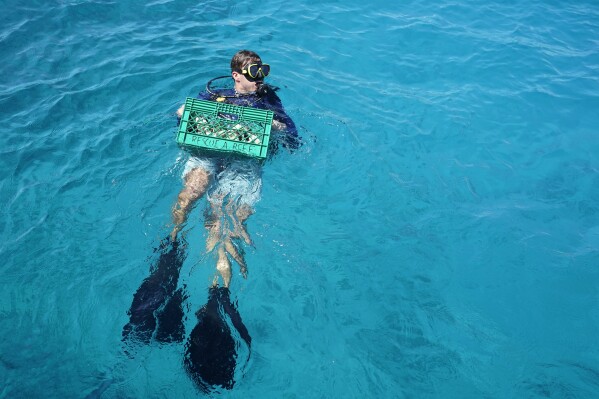
University of Miami Rosenstiel School of Marine, Atmospheric, and Earth Science senior research associate Dalton Hesley swims out with supplies, Friday, Aug. 4, 2023, on Paradise Reef near Key Biscayne, Fla. (AP Photo/Wilfredo Lee)
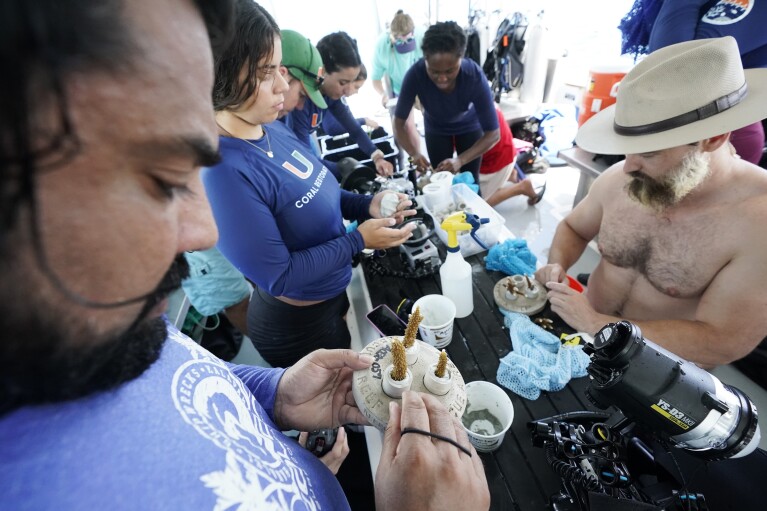
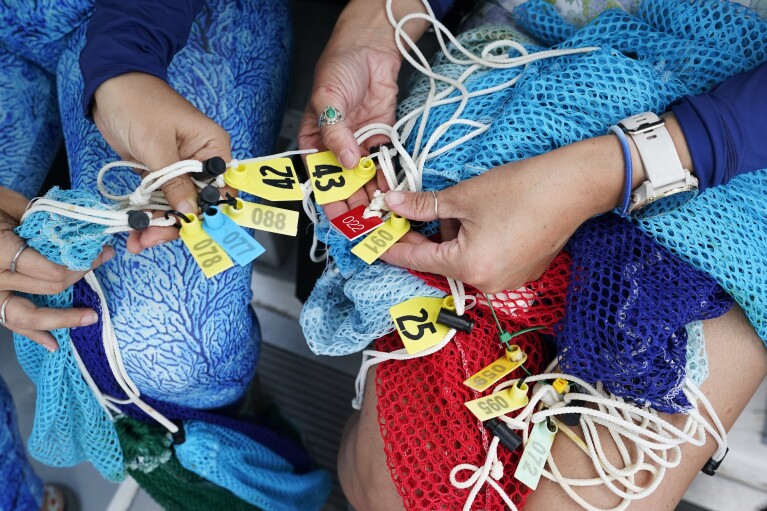
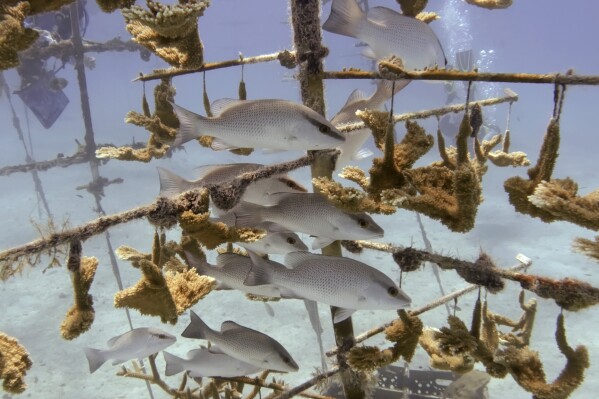
Fish gather in a coral nursery, Tuesday, Aug. 1, 2023, near Tavernier, Fla., in the Florida Keys. (AP Photo/Wilfredo Lee)
Up and down the chain of islands that form the Florida Keys, coral rescue groups and government and academic institutions have mobilized to save the coral from a historic bleaching event that experts say threatens the viability of the third-largest reef tract in the world. They’ve been working long days and weekends in blistering heat for weeks to get as many specimens as they can onto land amid reports of some reef tracts experiencing near total mortality.
In mid-July, water surface temperatures averaged about 91 degrees (33 Celsius) off the lower Florida Keys, well above the average of 85 degrees (29.5 Celsius), according to National Oceanic and Atmospheric Administration reports.
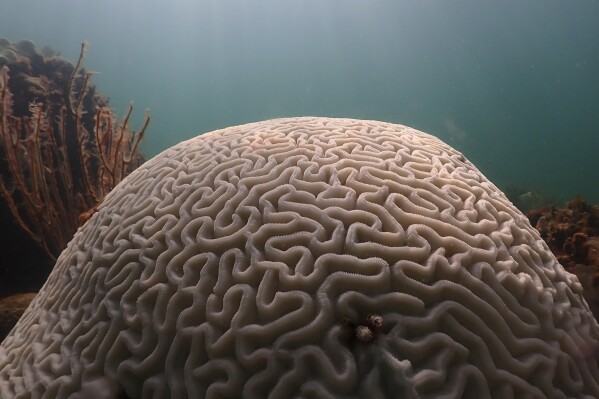 South Florida waters hit hot tub level and may have set world record for warmest seawater
South Florida waters hit hot tub level and may have set world record for warmest seawater
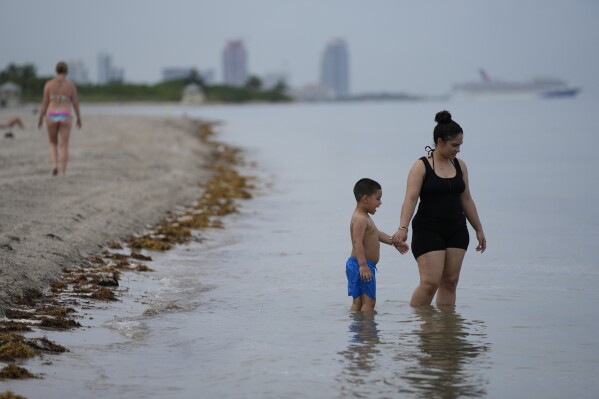 Water is refreshing in the heat, right? In parts of Florida this past week, not so much
Water is refreshing in the heat, right? In parts of Florida this past week, not so much
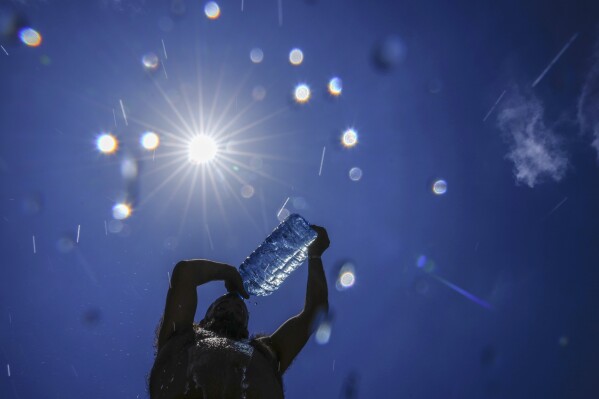 European scientists make it official. July was the hottest month on record by far
European scientists make it official. July was the hottest month on record by far
The hot water resulted in nearly 100% bleaching along portions of the reef, causing the corals to lose their zooxanthellae, the algae that gives them color and nourishment. If they don’t recover their zooxanthellae, they will ultimately die.
“We’re already seeing not just bleaching, but actual coral death out on the reef because the temperatures were so hot,” said Cynthia Lewis, director of the Keys Marine Lab, a research institute on the island of Long Key, some 100 miles (160 kilometers) south of Miami, where rescue groups have already brought more than 1,500 pieces of coral. “And we can’t afford to lose more of our reef.”
A coalition of groups has rushed to the Florida Keys to rescue coral from historic bleaching amid abnormally high temperatures. (Aug. 9)(AP video by Daniel Kozin and Wilfredo Lee)
Coral bleaching occurs naturally when waters warm significantly, including in 2016 in the Keys. But Lewis said the current situation is urgent for coral, which is vital to Florida’s economy, coastal protection and marine life.
The corals “don’t have a lot of time,” she said. “They’re literally sitting, stewing in the water out there in these hot, hot temperatures.”
A string of recent overcast and rainy days helped drop water temperatures slightly. But it will likely be late October or November before the coral samples can be returned to the reef, Lewis said.
What’s at stake?
The Florida Coral Reef is the world’s third-largest, extending about 350 miles (563 kilometers) from the Dry Tortugas in the Gulf of Mexico to St. Lucie Inlet, some 115 miles (185 kilometers) north of Miami.
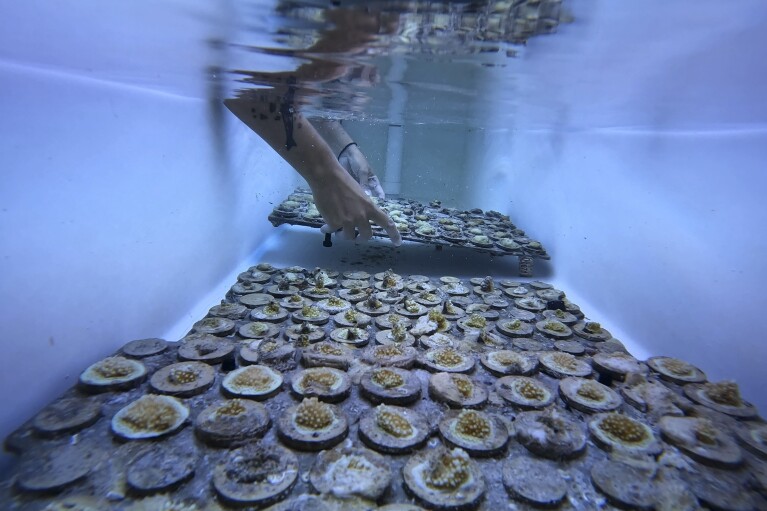
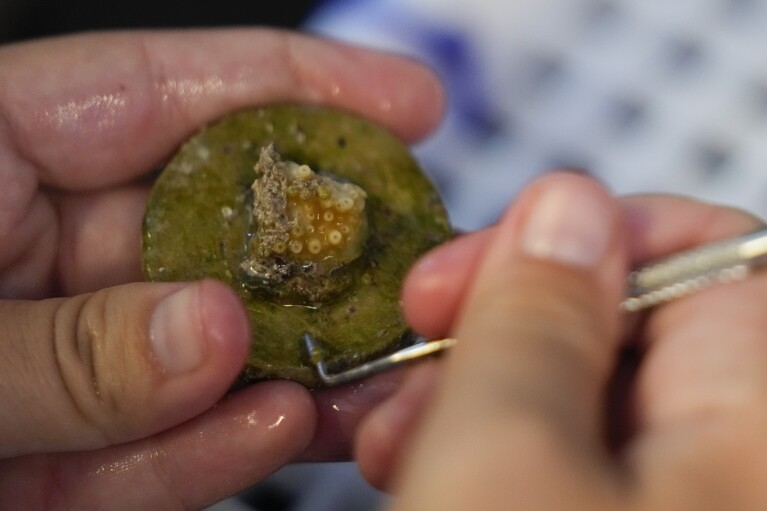
The reef is a first line of defense against erosion and flooding from hurricanes and tropical storms, Lewis said. It helps support commercial fishing and a thriving tourism industry, from snorkeling and scuba diving to recreational fishing. And they nurture “such an amazing amount of diversity and life” in the ocean around them, she said.
“In a normal situation, they’re like the rainforests of the ocean,” Lewis said. “They’re incredibly important.”
The world’s oceans have been record-setting hot since April, with scientists citing climate change from the burning of coal, oil and natural gas along with a boost from El Nino, a natural warming of parts of the Pacific that changes weather worldwide and generally heats the planet.
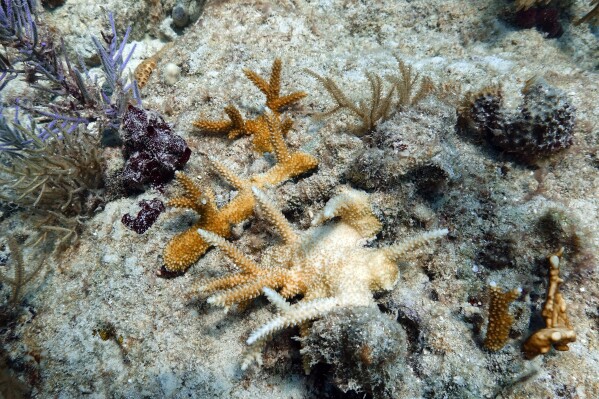
A partially bleached staghorn coral that was planted by scientists is visible, Friday, Aug. 4, 2023, on Paradise Reef, near Key Biscayne, Fla. (AP Photo/Wilfredo Lee)
The bleaching occurred rapidly as the water temperature rose in July.
“We got kicked in the teeth because if happened so fast in the Lower Keys. I mean, within a week,” said Michael Echevarria, president of the nonprofit Reef Renewal USA.
Reef Renewal was among those who initially worked to move endangered coral into land-based facilities. More recently, they’ve worked to save coral in several of their own underwater nurseries in shallower water by moving them to deeper, cooler water, where they hang pieces of coral from tree-like structures.
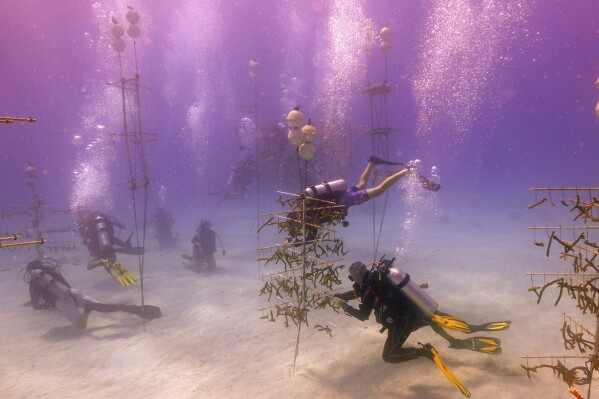
Scientists and volunteers clean equipment in a coral nursery, Friday, Aug. 4, 2023, near Key Biscayne, Fla. (AP Photo/Wilfredo Lee)
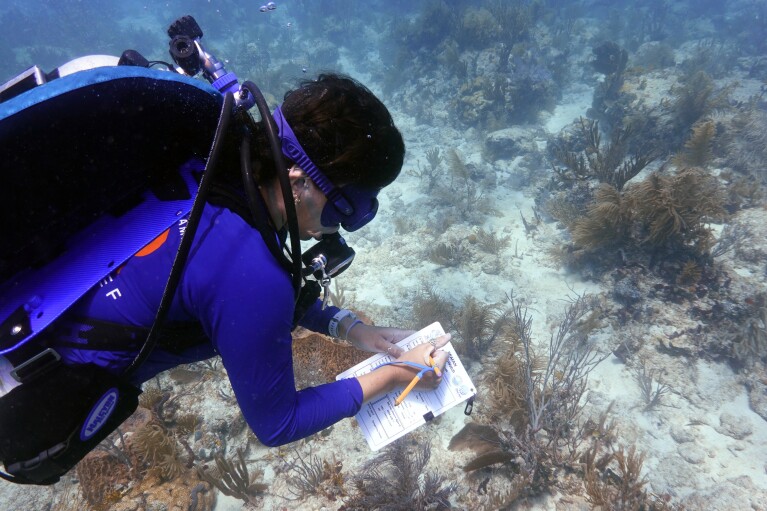
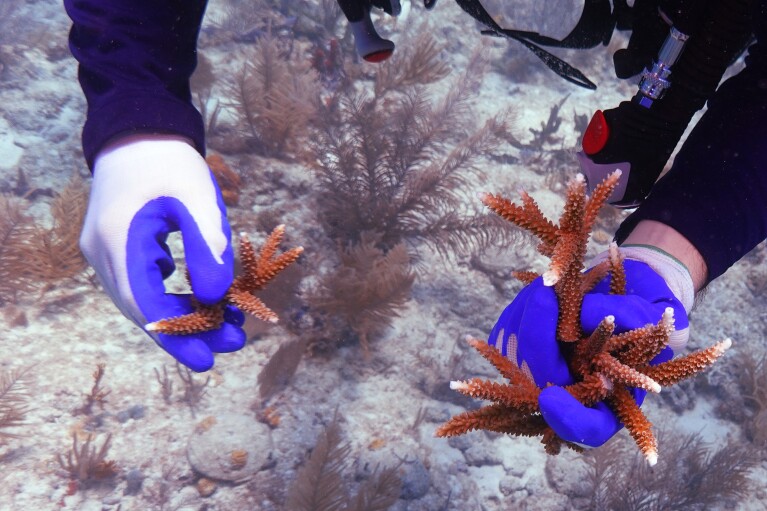
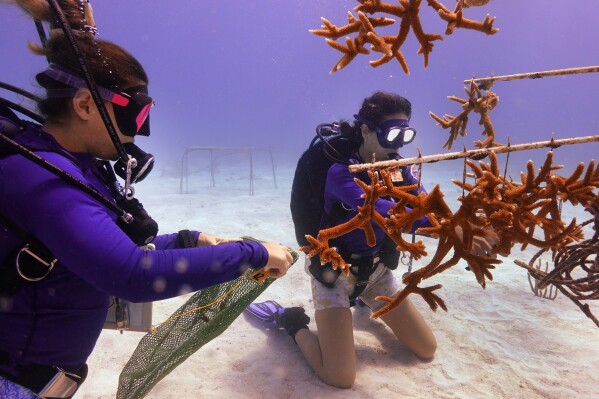
Grad student Berfin Sagir, left, and Research associate Catherine Lachnit collect coral fragments to be transplanted, Friday, Aug. 4, 2023, near Key Biscayne, Fla. (AP Photo/Wilfredo Lee)
Reef Renewal founder Ken Nedimyer called the coral bleaching “hard to watch and hard to experience” and said his group knew that coral stress would increase under climate change, but didn’t think it would come so soon.
“There’s a lot of people that think this isn’t real, that climate change is not real, and that the world is not warming up. And I don’t care what they say, it’s real. I’m living it right now and I’ve lived down here and done this for a long time,” he said. “And I’ve never seen this.”
Back at the Keys Marine Lab in Layton, the collected pieces of coral are placed in cooling trays set up on tables that hold between 40 and 400 gallons of seawater. The 85-degree water (29 degrees Celsius) makes for “much happier coral,” Becker said.
“We’ve seen some coral that have been really stressed offshore, come back into our tables and recover already,” she said. “They’re already getting color back. So that’s really encouraging to see that.”
The work goes beyond saving the coral. Becker and others are studying different types of coral to see which ones survive temperature stress and disease better, hoping to “build a better reef with more resilient corals,” she said. Scientists from the University of Miami have established a restoration research site off of Key Biscayne to do such work.
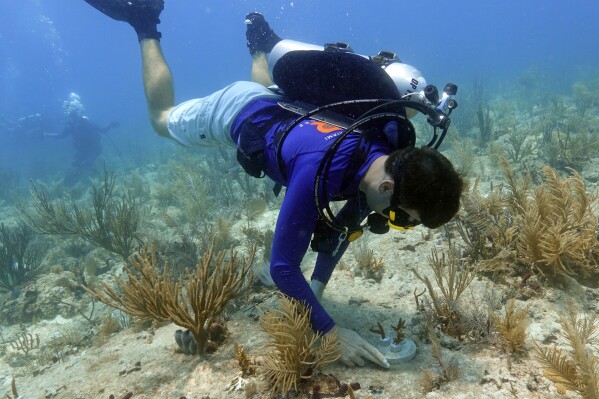
University of Miami Rosenstiel School of Marine, Atmospheric, and Earth Science senior research associate Dalton Hesley cements coral fragments to the reef, Friday, Aug. 4, 2023, on Paradise Reef near Key Biscayne, Fla. (AP Photo/Wilfredo Lee)
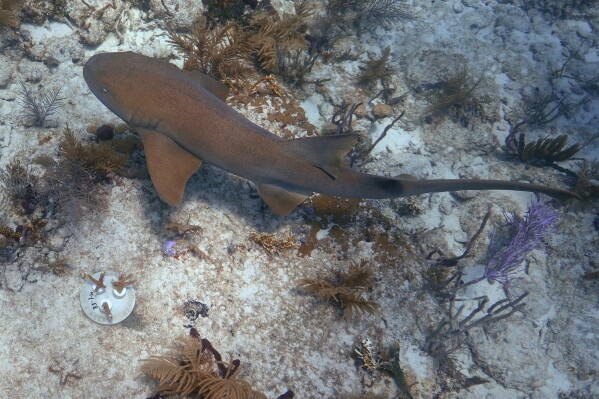
A nurse shark swims past a newly placed “cookie”, lower left, containing three coral fragments, Friday, Aug. 4, 2023, on Paradise Reef near Key Biscayne, Fla. (AP Photo/Wilfredo Lee)
Jamison Gove, co-author of a new article in Nature about how Hawaii coral reefs weathered a 2015 marine heat wave that pushed ocean temperatures to their highest levels in 120 years of record-keeping, said his research suggests some corals off Florida may survive better than others depending on the health of local fish populations and runoff from land.
The Honolulu-based research oceanographer with NOAA said reefs that rebounded best after Hawaii’s heat wave were those that had both the most fish and the least exposure to sewage from cesspools and septic systems.
But he said local management measures won’t save reefs if people don’t cut greenhouse gas emissions.
The effort to save Florida’s coral is appreciated by Jennifer Cullen, manager of Rain Barrel Village, a souvenir shop in nearby Islamorada.
“I’m worried about the coral. I’m worried about tourism, worried about stronger hurricanes, because we’ve already had Hurricane Irma, which was devastating for the Keys and tourism,” Cullen said. “It was a very long recovery, and I don’t know how much more of that we can take.”
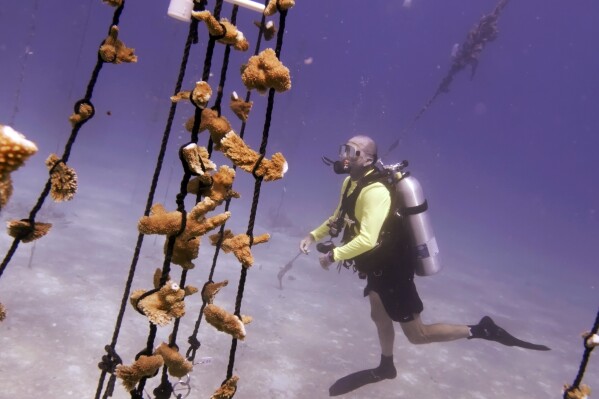
Bob Whitmore, a board member with the nonprofit Reef Renewal USA, swims past a coral nursery that the organization is moving to deeper waters, Tuesday, Aug. 1, 2023, near Tavernier, Fla., in the Florida Keys. (AP Photo/Wilfredo Lee)
___
Associated Press writers Seth Borenstein contributed to this report from Washington and Audrey McAvoy from Honolulu. Frisaro reported from Fort Lauderdale, Florida. Lee reported from Key Biscayne and Tavernier, Florida.
___
Associated Press climate and environmental coverage receives support from several private foundations. See more about AP’s climate initiative here. The AP is solely responsible for all content.
Disclaimer: The copyright of this article belongs to the original author. Reposting this article is solely for the purpose of information dissemination and does not constitute any investment advice. If there is any infringement, please contact us immediately. We will make corrections or deletions as necessary. Thank you.






